Understanding how your customers experience your product helps you improve your website or service, drive customer satisfaction, and grow your business.
But with so many tools available to track churn rates, NPS® scores, and other metrics of user delight, choosing the right customer satisfaction software can be tricky.
Summary
The 10 best customer satisfaction (CSAT) tools are:
Zendesk: an all-in-one customer service platform that helps you stay on top of messaging and communications
Contentsquare: a digital experience intelligence and analytics platform stacked with tools like heatmaps, session replays, continuous feedback collection, and more to help uncover the reasons behind your customer satisfaction levels
Feedbackly: customer satisfaction and sales tools designed to collect feedback and identify bottlenecks or problem areas in your users' experience throughout the entire customer journey
HelpDesk: customer support ticketing service with built-in automation and streamlining features
VideoAsk: a multimedia messaging service that lets you communicate with your customers in more creative, engaging, and personalized ways
Zoho CRM Plus: a multi-channel customer experience platform that promotes cross-team collaboration
Medallia Experience Cloud: a voice of customer tool to collect granular operational and transactional data on customer pain points
Tidio: a live chat software that lets your team deliver agile and automated support to help increase conversions
SurveyMonkey: a customer satisfaction tool that you can build and send professional surveys
Nicereply: online customer satisfaction survey software that lets you gather feedback at every step in the customer journey
Choosing the right CSAT tool ultimately comes down to the specific needs and goals of both your business and your customers
Top 10 customer satisfaction tools to reach business goals
Deciding on the right tool for your business depends on your unique product offering and user journey. Each tool performs differently and many target different customer satisfaction metrics. While some companies use surveying and feedback functions to understand users, others focus on improving customer service or refining their sales funnel.
Pro tip: use tools that collect both quantitative and qualitative data about your customers and their experiences to get a complete picture of customer satisfaction. This way, you’ll have raw figures on user numbers and churn rates that tell you how many customers are engaging with your product—but you’ll also get granular insights that help you understand your users' motivations behind hard data.
As you read through our list of recommended tools, think about what customer satisfaction techniques will form the main part of your strategy, and select tools that'll help you measure and meet your business goals. These 10 tools will help you create a smooth customer journey and achieve your customer satisfaction goals:
1. Zendesk
Zendesk is a customer service tool that lets you organize all your customers’ information in one platform. It gives you a clear overview of your users and their pain points, helping you increase customer satisfaction by giving your customers a quick response to their queries, whether by phone, email, chatbot, social media, or SMS.
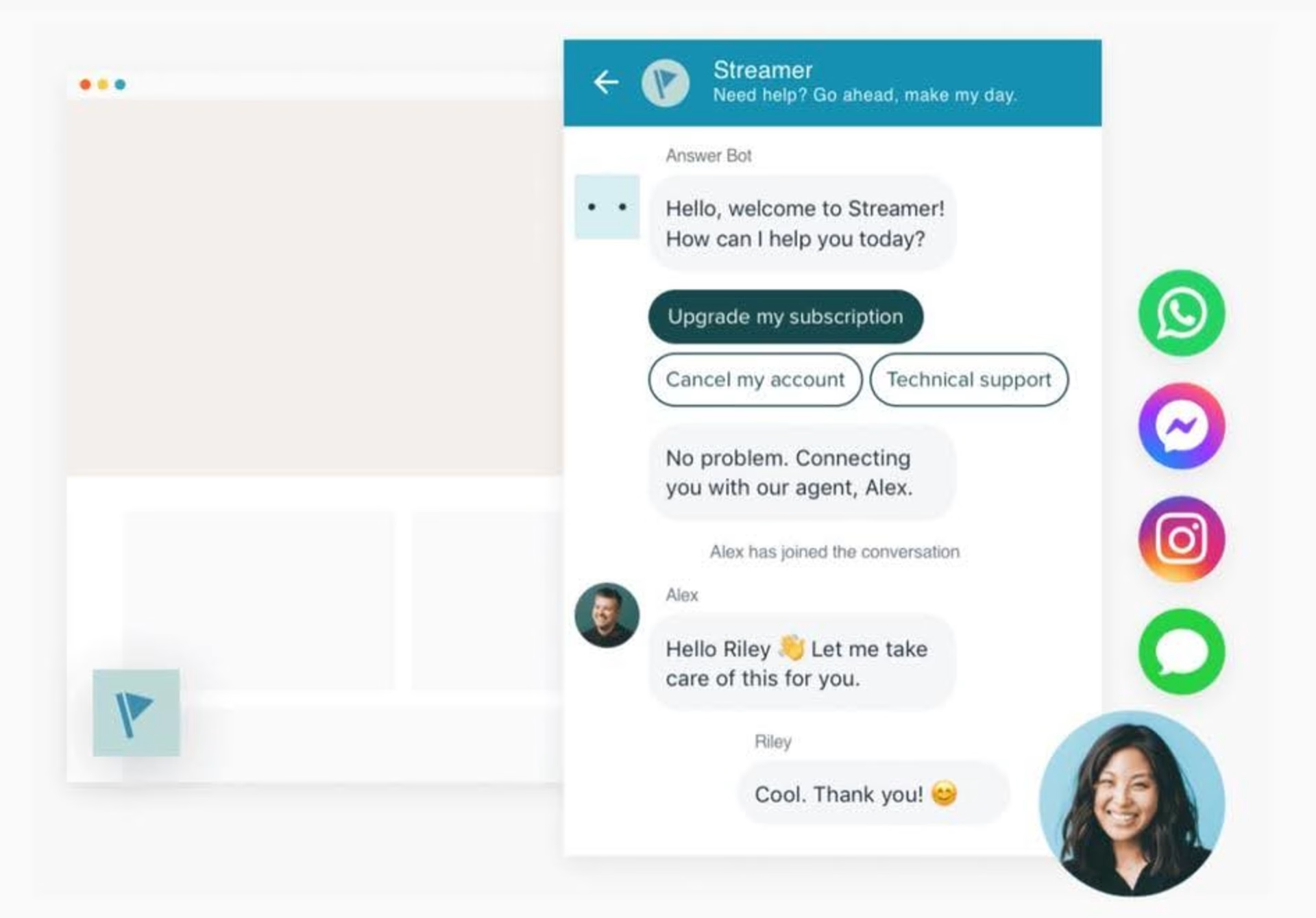
Zendesk offers support across multiple platforms to help users get the answers they need. Source: Zendesk
Zendesk lets businesses give users choices about when and how to contact them and helps support teams stay on top of messaging and customer communications. It helps you improve customer satisfaction by tracking
New tickets so you can see how many customers contacted your support team over a period of time
Solved tickets to show if your team is keeping on top of customer issues
Backlog of unsolved tickets
Satisfaction ratings
‘First-time reply’ that shows you the average amount of time it takes an agent to reply to a ticket
2. Contentsquare
Contentsquare’s digital experience intelligence and analytics tools explain the why behind your customer satisfaction levels, so you know exactly what to improve.
How Contentsquare tools give you an insider’s view of your customer experience (CX):
Zone-Based Heatmaps visually represent where users move on your site to show which features they like and click on, and what you need to improve
Session Replays give you a fly-on-the-wall experience, letting you watch your customers as they experience your product. During key moments like onboarding, replays give you deep insights into what helps users achieve their goals and where they’re getting stuck, helping you make quick decisions to improve your customers' experience and satisfaction levels.

Contentsquare’s Session Replays let you see your users’ journey through your site
Contentsquare’s Voice of Customer tools take away the guesswork from understanding customer satisfaction by telling you exactly what your users think as they navigate your site or product.
Live Feedback Collection tells you how customers are experiencing particular pages, features, and site elements. For example, if an ecommerce site user gets stuck during checkout, they can send you feedback and highlight the part of the page that’s causing problems.

Find out what users really think about your site with Contentsquare’s Feedback Collection widget
NPS and Exit Intent Surveys let you ask customers how they’re experiencing your product or service at key moments in the customer journey. Surveys can help you measure your CSAT score—and understand it.
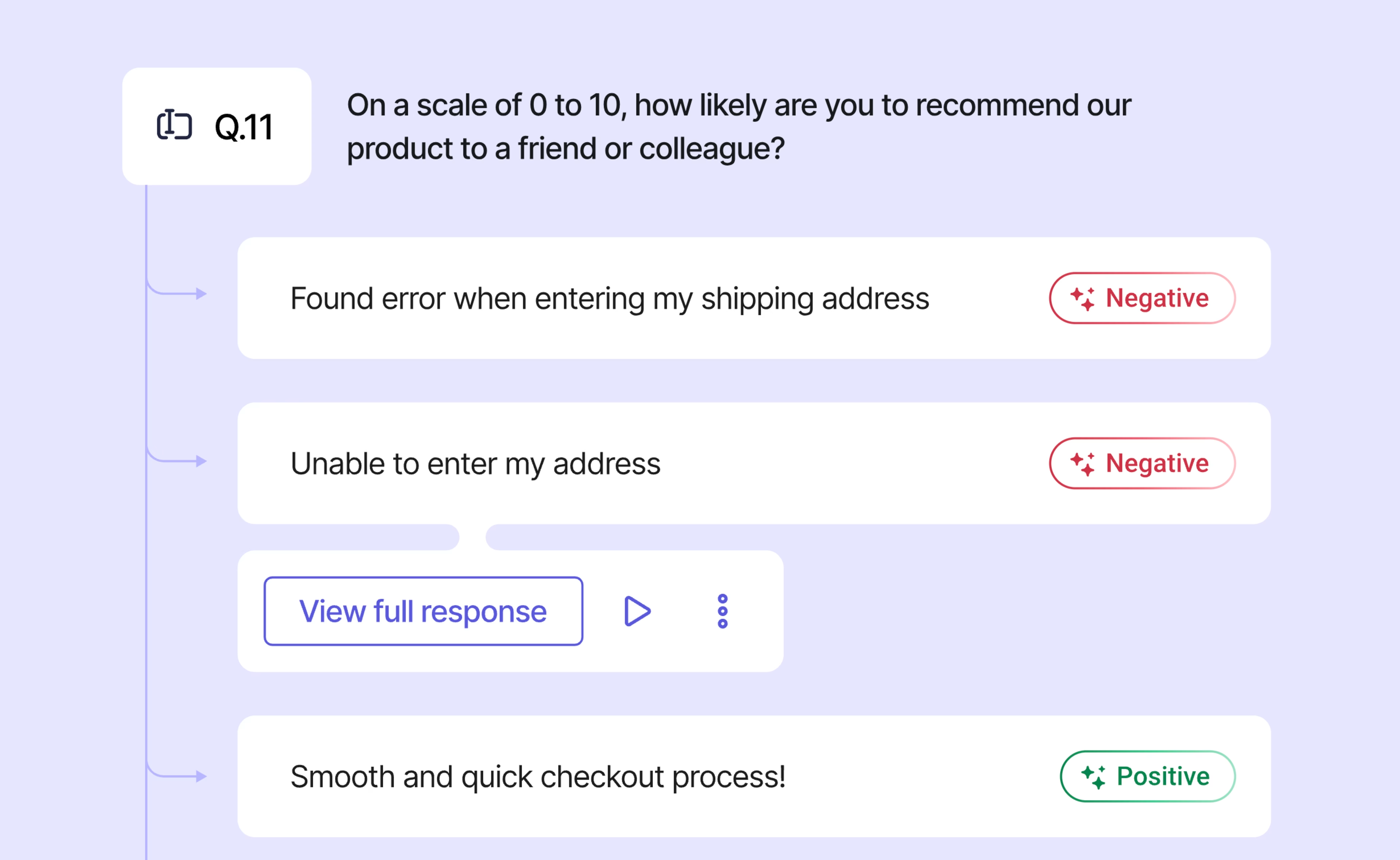
Use Contentsquare’s Exit Intent Surveys to evaluate satisfaction at key moments in your user's journey
Contentsquare’s all-in-one experience platform gives you a visual overview of your user experience (UX) data to help you understand your customer insights, while Journey Analysis helps you zone in on the most interesting UX clips and feedback throughout the customer journey to share with your team and stakeholders to get buy-in for product updates.
💡 Pro tip: use an exit intent survey to improve your customer satisfaction levels by asking users who bounced why they left your site. You can provide a drop-down list of options with answers like, “I didn’t find what I was looking for” or “I couldn’t get the payment form to work.” Then, filter your Session Replays for users who leave to see what went wrong through their eyes.
3. Feedbackly
Feedbackly is a customer satisfaction tool with its own marketing and sales software that helps you understand customer experience feedback to improve your sales. It asks customers what they’re feeling—like sadness, joy, or disappointment—at various points throughout their journey, to uncover the emotions behind customer satisfaction metrics like customer churn.
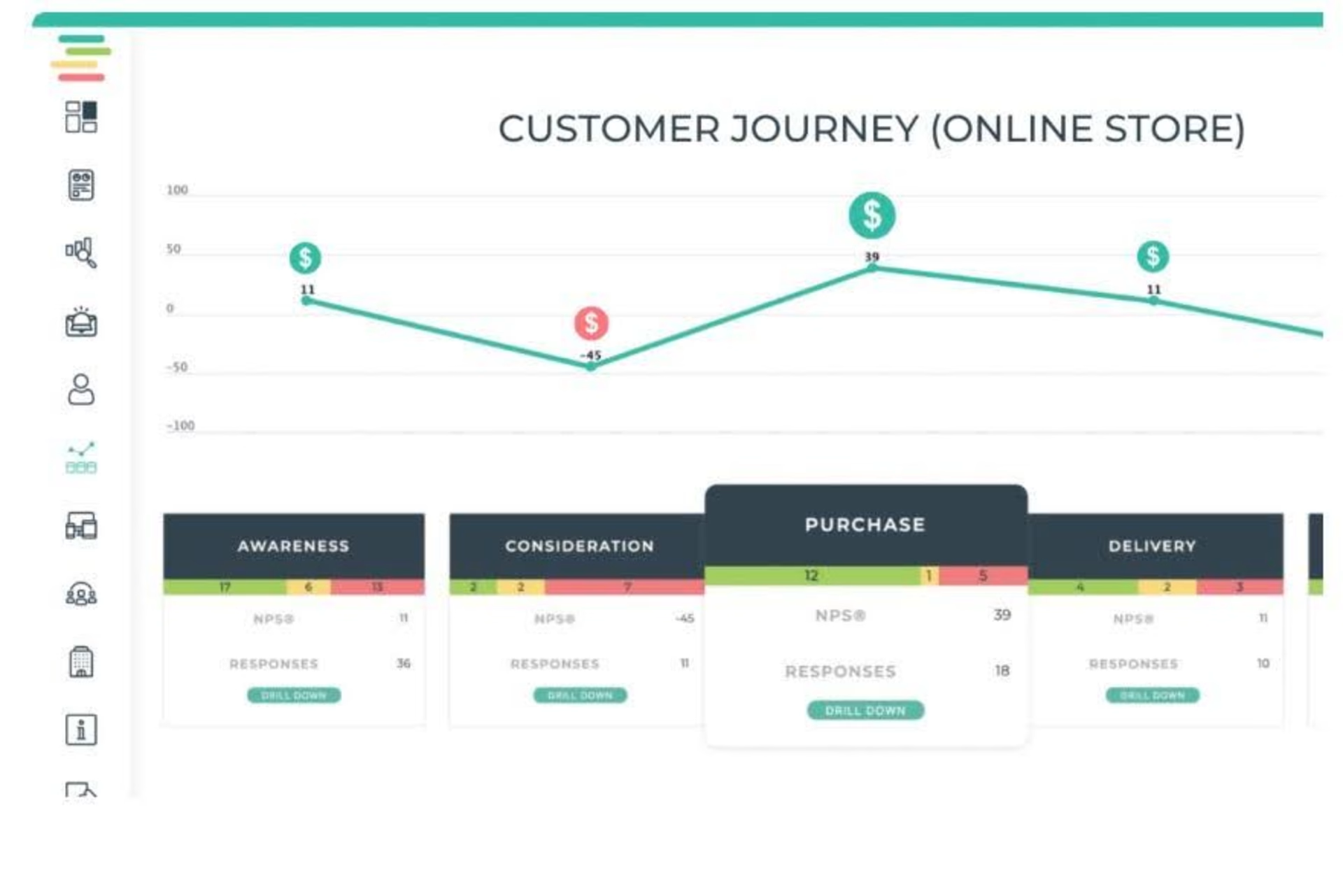
Feedbackly asks customers how they’re feeling at each stage of the journey to help you uncover and fix problem areas. Source: Feedbackly
Feedbackly’s 'Customer Journey Builder' feature also helps you map out multiple customer journeys and track how your users are feeling in real time.
If you run an online store, Feedbackly can help you identify bottlenecks or problem areas in your users' product experience (PX). For example, during the consideration stage of the customer journey, Feedbackly highlights where customer emotions drop to a rate that correlates with abandoning the customer journey—so you can make changes to improve it.
4. HelpDesk
HelpDesk is a ticketing management system that lets teams centralize customer correspondence and improves customer satisfaction by streamlining their interactions with help centers and customer service agents. It automates tasks with pre-written responses and bulk actions so you can address similar customer tickets in a single batch.

HelpDesk gives users a clear view of the status of each message. Source: HelpDesk
HelpDesk lets teams collaborate with a single dashboard view of tickets and ticket history, avoiding clashes between agents. The software's analytics measure performance and use data to improve customer satisfaction by tracking
Ticket satisfaction rates
First response time
Peak times in new ticket generation
5. VideoAsk
VideoAsk is a web app that lets you exchange video messages with your customers. It works like a customer service chatbot but with video messaging that creates a more personalized user experience.
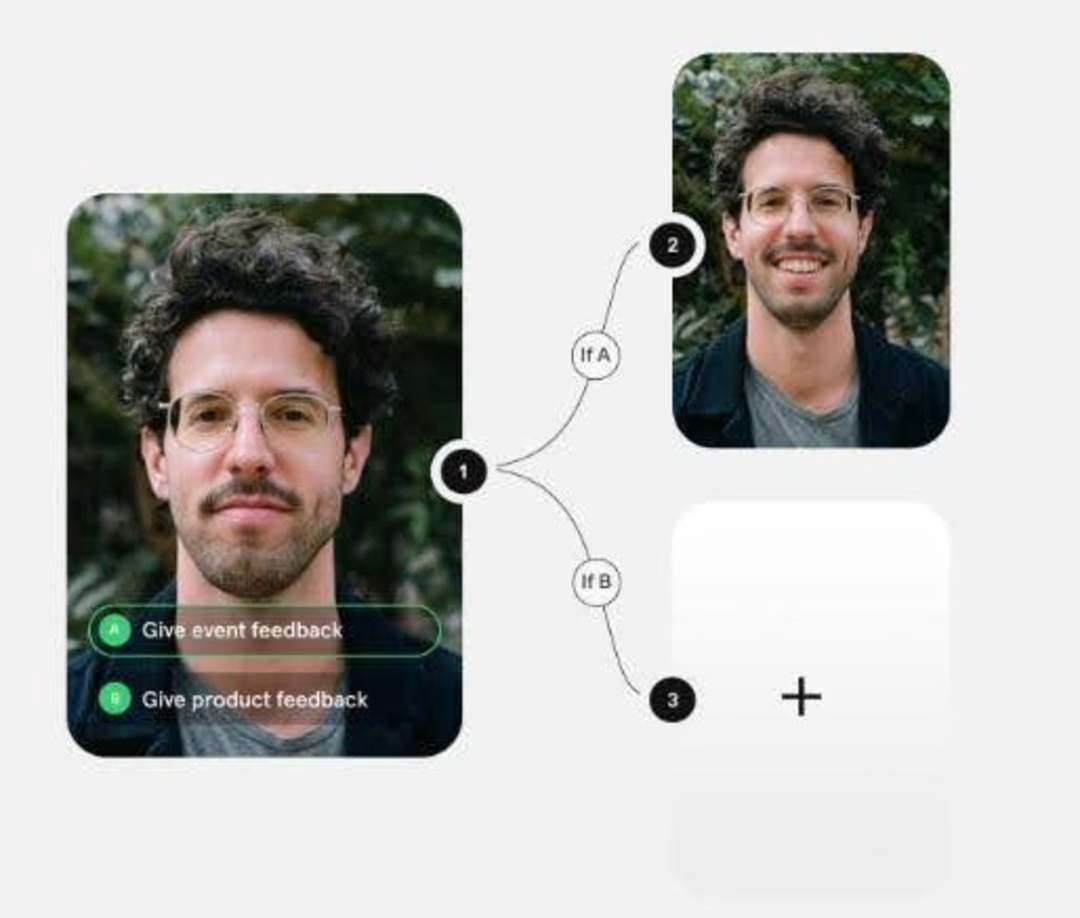
VideoAsk lets you create a flow of video messages depending on customer responses to prompts. Source VideoAsk
VideoAsk lets you share videos on your site or by email, and customers can respond with video, audio, or text. Set up a chain of questions in a single VideoAsk, so that after a customer answers your first question, your next video appears, showing a follow-up query.
VideoAsk tracks visits, clicks, answers, and completions in your dashboard. You can also see when users drop off during a VideoAsk funnel to better engage customers to reach the end of the sales funnel.
To deal with urgent customer queries, you can channel video feedback into a live face-to-face call where needed.
6. Zoho CRM Plus
Zoho CRM Plus is a customer experience platform that helps businesses improve CSAT by engaging with customers across multiple channels. It promotes cross-team collaboration with a single platform for viewing leads and support tickets, and uses an AI assistant to predict the best time to contact a customer.
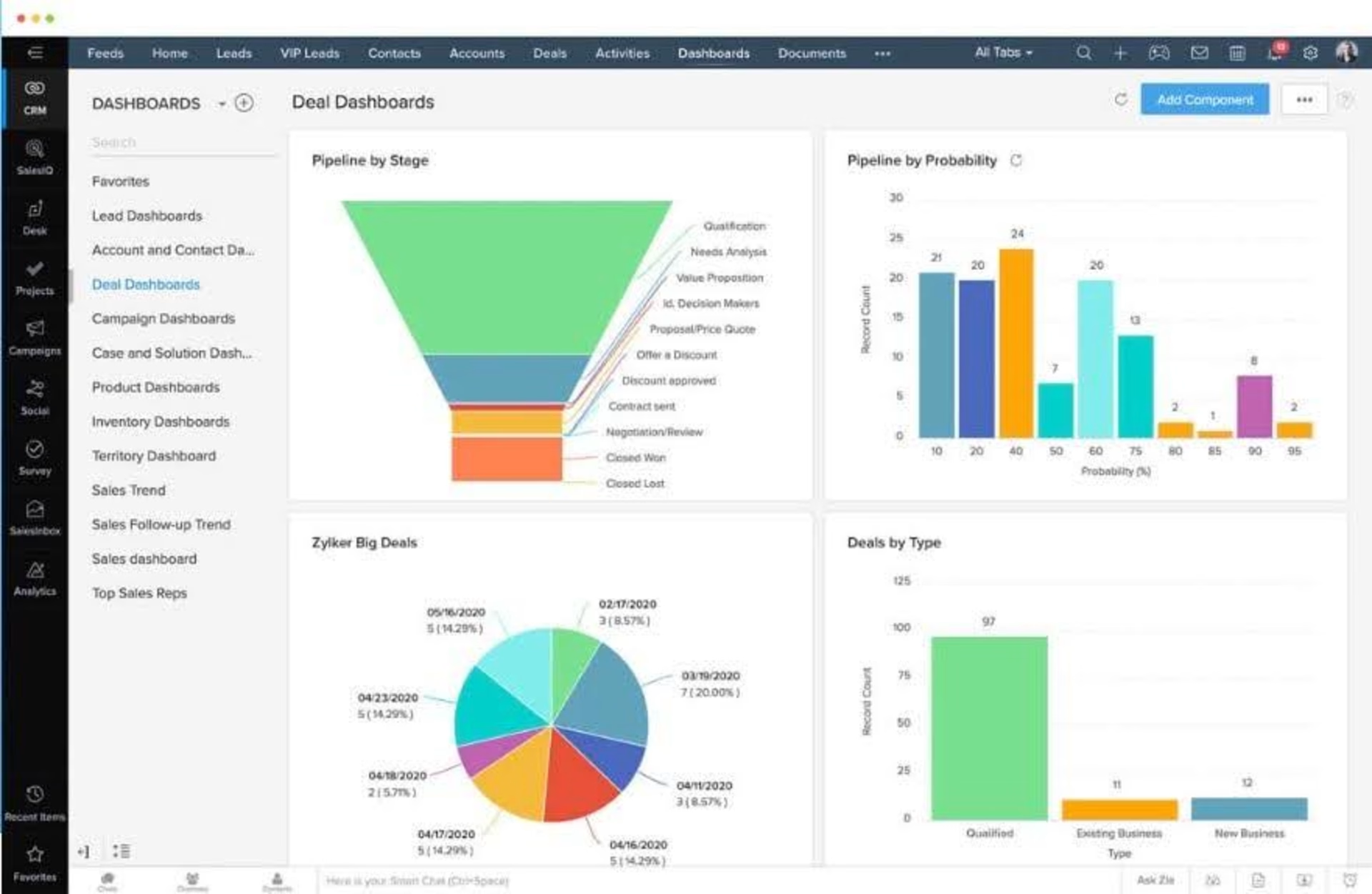
Create your own charts and funnels to see how your customer service is performing. Source: Zoho
Zoho CRM Plus supports customer communication through chat, email, phone, or via a 24/7 live representative, and converts customer posts from X (formerly Twitter) into support tickets.
The software's prebuilt analytics dashboards let you compare performance by stages you determine (see the image above). You can generate your own charts and funnels to get a clear overview of how well your product meets your customer's needs.
7. Medallia Experience Cloud
Medallia Experience Cloud helps businesses understand customer satisfaction by gathering voice of customer (VoC) insights from emails, social media, web, or in-app messaging. The software lets you combine customer feedback with operational and transactional data on your product, so you fully understand every touchpoint in the customer journey.
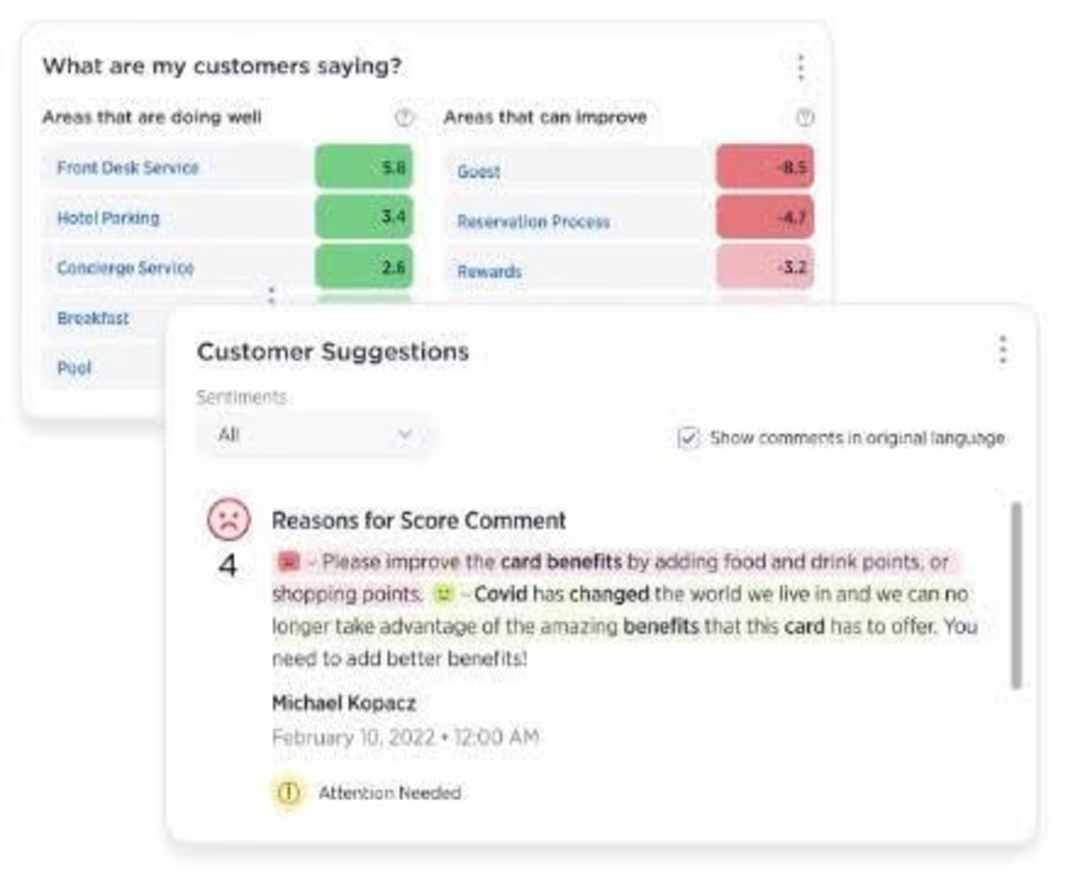
Medallia helps uncover meaningful insights from unstructured feedback messages. Source: Medallia
Medallia collects text data and voice-based feedback, as well as information on the user journey to identify customer pain points and determine the best way to resolve them.
For example, PayPal used Medallia to improve its customer satisfaction rates by collecting 4 million surveys in 27 languages via interactive voice response (IVR), phone calls, email, and back-office interactions over the course of a year. The result was 40 million fewer issues compared to the previous year, according to PayPal President David Marcus.
8. Tidio
Tidio is a live chat software that combines messages from email and website chat widgets in a single dashboard to help customer service and support teams respond quickly to customers. It also lets you build your own chatbot to help increase conversion rates with templates available for common themes—like offering discounts to returning customers or contacting customers who abandon their shopping carts.
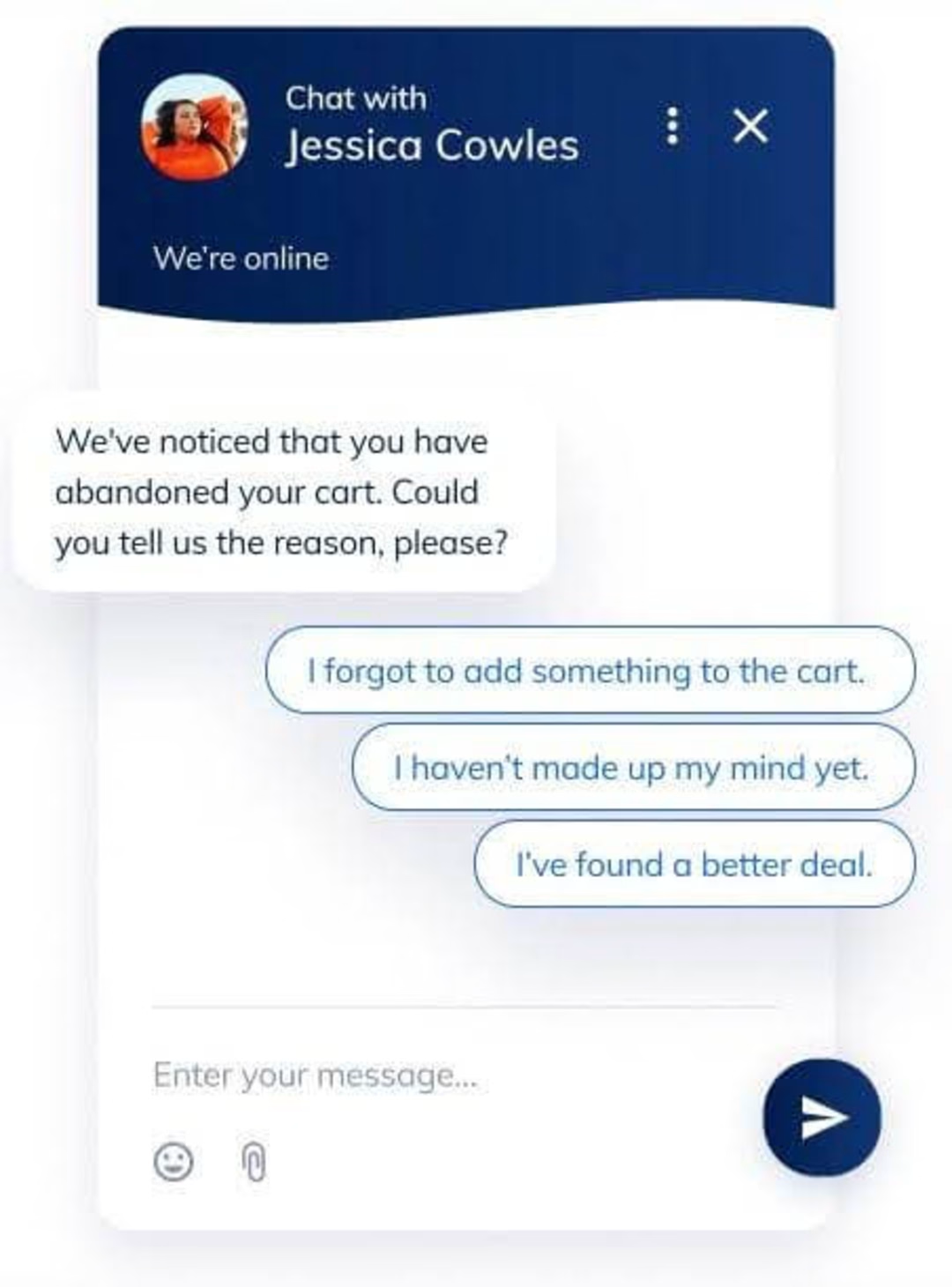
Tidio’s automated chatbot lets you engage with customers at key moments in the user journey. Source: Tidio
Tidio lets you customize your website's chat widget and add a pre-chat survey to collect user data before your talk begins. You can also set up triggers for particular user actions—like your customers making a purchase or spending a certain amount of time on a page—to automatically generate chat messages or emails when that event occurs.
For example, a B2B software company can send an email to customers who abandon onboarding before they've completed all the necessary steps to find out what blocked them and improve their onboarding experience—and overall satisfaction scores.
9. SurveyMonkey
SurveyMonkey is a customer satisfaction tool that helps businesses collect, evaluate, and share survey responses from users. It helps you create professional-looking surveys to gather insights about all aspects of your user experience to make informed product and website decisions.
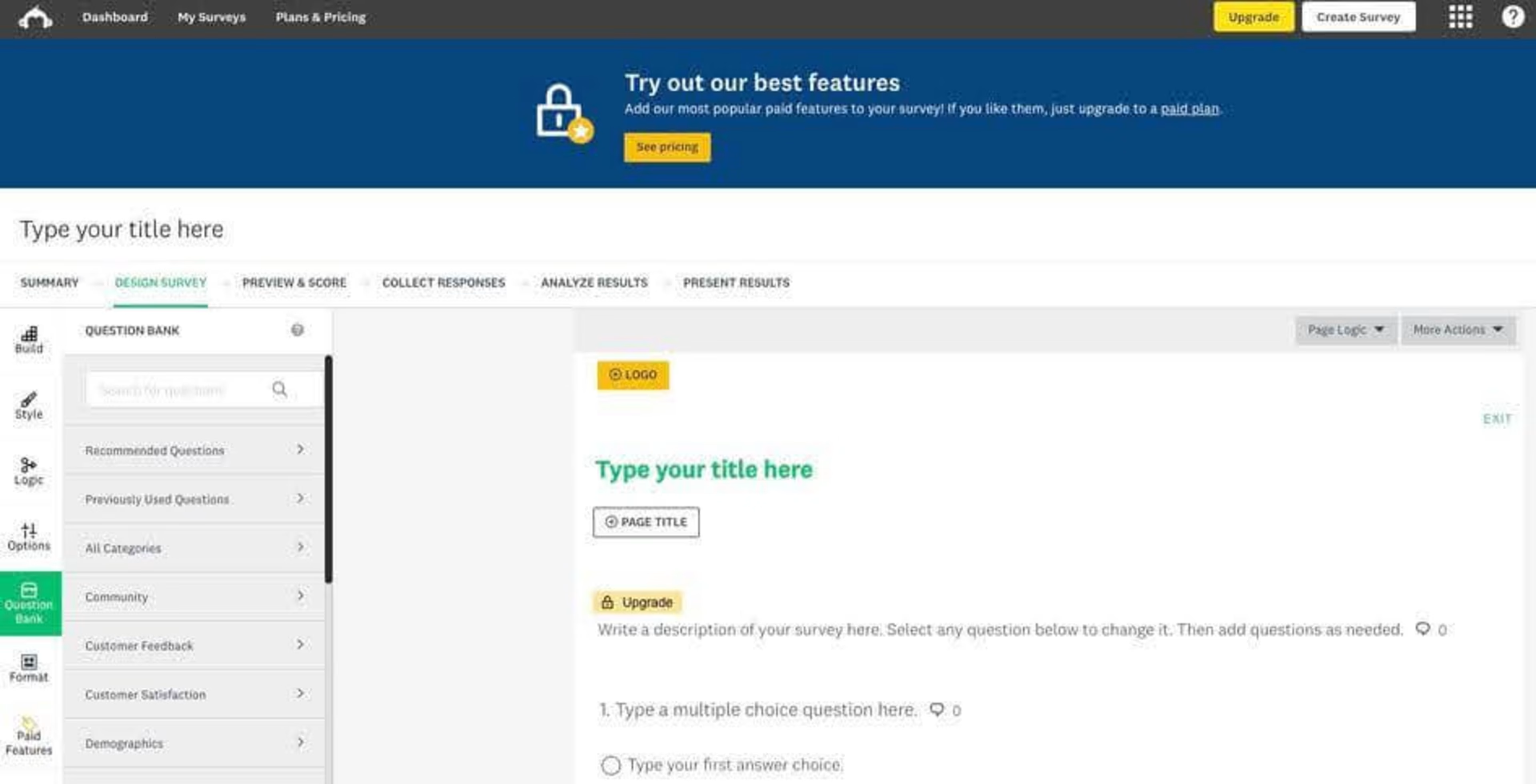
SurveyMonkey walks new users through the process of setting up a survey with suggestions for questions from a range of fields. Source: SurveyMonkey
SurveyMonkey Genius lets you choose from a range of survey templates and sample questions, and assess the success of your survey. The software's analytics dashboard lets you view insights and data trends from your surveys and present your findings to colleagues and stakeholders to help you get buy-in for product improvements.
SurveyMonkey also helps you test new features—you can include screenshots of your new product in your survey and ask users to click on the areas they like or dislike, then ask them more detailed questions after they’ve tried it out.
10. Nicereply
Nicereply is an online customer satisfaction survey software that lets product and marketing teams measure their CSAT, Net Promoter Score (NPS), and Customer Effort Score (CES 2.0), helping them understand their customers to better meet their needs.
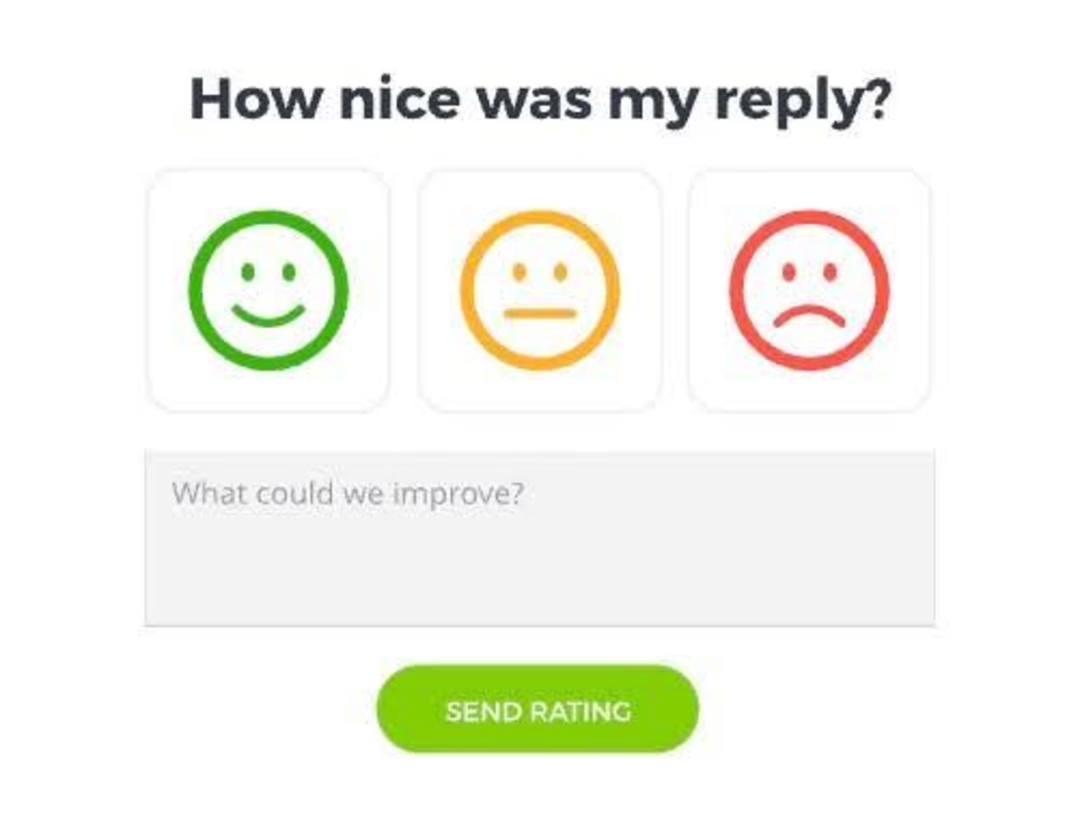
Nicereply lets businesses ask users for feedback at every step of the customer journey. Source: Nicereply
Teams use Nicereply email surveys to check on customers after resolving a ticket, conversation, or chat, or survey links at customer touchpoints to gather feedback about the user experience. Teams can also customize surveys with their own branding and images.
Nicereply lets you view your survey results in a dashboard that identifies trends in CSAT, NPS, and CES performance, as well as response rates.
Choosing the right customer satisfaction tools for your business
The right tool depends on your specific business needs and customer satisfaction goals.
Whichever option you go for, it’s essential to have clear and detailed insights about why some aspects of your customer journey work better than others. Combine customer satisfaction analytics and customer service tools with qualitative user insights to better meet your customers’ needs and see your customer satisfaction scores skyrocket.
Frequently asked questions about customer satisfaction tools
What are customer satisfaction tools?
Customer satisfaction tools help you achieve your customer service goals with software like messaging and chatbots. They also measure the success of your customer satisfaction goals with metrics like customer retention and churn rate, and tell you how your customers are feeling at a particular moment.
What do customer satisfaction tools measure?
Customer satisfaction tools measure customer satisfaction metrics including:
Referral rate
Conversion rate
CSAT score
Engagement rate
NPS score
Click-through rate
Exit rate
Customer churn rate
Customer effort score
How can Contentsquare help you measure customer satisfaction?
Contentsquare’s tools like Session Replays and Zone-Based Heatmaps give you insights into the customer experience, so you can see which parts of your website work and which you need to improve. Feedback Collection and Survey tools capture voice of customer to tell you exactly how they’re feeling at a particular point in the user journey.
Net Promoter®, NPS®, NPS Prism®, and the NPS-related emoticons are registered trademarks of Bain & Company, Inc., NICE Systems, Inc., and Fred Reichheld. Net Promoter ScoreSM and Net Promoter SystemSM are service marks of Bain & Company, Inc., NICE Systems, Inc., and Fred Reichheld.
